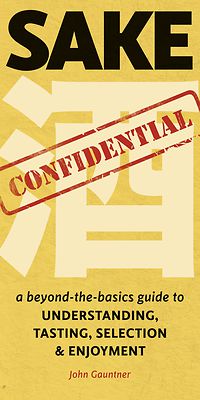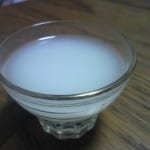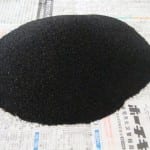Amidst the veritable cornucopia of sake available today, a handful of them are labeled “unfiltered.” A small handful, admittedly, but the number of sake with this term on the bottle seems to be growing.
Amongst sake labeled as “unfiltered” in English, some are white and cloudy. This is easy to figure out; it is cloudy because they did not filter it. But other times we see unfiltered and it is totally clear. What gives?
The key to understanding this is to realize that there are two “filtrations,” but they are called different things in Japanese, but the best English translation for both is filtration.
Let us look at the cloudy stuff first. It seems obvious that it has not been filtered. Cloudy sake like this is nigori-zake, as many readers are aware. Nigori means cloudy, and nigori sake is sake that has in fact been filtered, but coarsely so.
When sake is made, the rice dissolves in the same tank in which the yeast converts the sugars (that are slowly trickled into the mash as the starch in the rice is converted) into alcohol and carbon dioxide. So when the 20 to 35 day fermentation is finished, the result is still full of undissolved rice solids. This is filtered out to yield clear sake.
When this filtration is done with a coarser mesh, i.e. one with bigger holes than normal, some (but not all!) of the rice solids are let through. This is nigori-zake. Note the term nigori can apply to any grade (although it is not commonly seen for higher grades), and while nigori is enjoyable, it is not nearly as refined as regular sake.
So, even though it is often called unfiltered, it is in fact coarsely filtered. (To be legally called sake, the fermenting mash must pass through a mesh of some sort.)
However, the word in Japanese for this step, shibori or jousou, does not mean filter, but rather means to squeeze or press, as that is what actually happens: the fermenting mash is pressed or squeezed through a mesh. Yes, the rice sediment is filtered out at this stage. But that is not how it is referred to in Japanese. And since there is another filtration later, often this step is called “ pressing” in English.
So one meaning of unfiltered is nigori, or coarsely pressed sake.
Sake’s original color
Next, after the sake is filtered…er, pressed, it sits for a bit to settle down, and at some point soon thereafter the brewer will dump a small amount of active charcoal powder into the just-made sake. This settles down to the bottom, pulling with it rougher flavors and elements that give sake its original and naturally beautiful lime-green-amber color. The sake is then passed through a series of paper filters to remove the remainder of the charcoal and the roughness it takes with it. This, obviously, is the second filtration, a charcoal filtration, and this step is called roka, which is the equivalent of the word filtration in English.
But some sake is made without this step, in other words, some sake is not charcoal filtered. There are those that feel their sake is clean enough to not need it. Others prefer the original goldenrod hue of sake and choose to retain it. Some sake is made so as to retain that mineral touch that can be present if charcoal filtering is eschewed. And some like to make sake (or market it) as close to its natural state as possible.
Reasons aside, if a brewer chooses to let everyone know the sake is unfiltered, the term muroka is used, indicating that the charcoal filtration step was skipped. This can mean a slightly more rambunctious flavor, but that is not a given! The difference may be in fact quite subtle, or even totally unnoticeable to most people.
Note, neither type is unequivocally better than the other. Charcoal filtering in the right measure is a good thing, but muroka has its appeal as well. And the differences are not that clear-cut in any event. That’s for sure.
Also, remember there is a lot of vagueness here. Sake can be filtered by solid state ceramic filters too, using no charcoal. But the term muroka is not legally defined, so some use it to mean no charcoal filtration even though a mechanical filter may have been used. Or not. It’s vague. It’s sake. We have to deal with that.
But to sum up and simplify, if the word “unfiltered” is on the label and it is white, it’s nigori. If the word “unfiltered” is on the label and it is clear, it is muroka. Chalk it up to linguistic idiosyncrasies, and enjoy your unfiltered sake.
 SAKE CONFIDENTAL
SAKE CONFIDENTAL
Interested in learning more about sake?
Check out my book “Sake Confidential” on Amazon.
Sake Confidential is the perfect FAQ for beginners, experts, and sommeliers.
Indexed for easy reference with suggested brands and label photos. Includes:
- Sake Secrets: junmai vs. non-junmai, namazake, aging, dry vs. sweet, ginjo, warm vs. chilled, nigori, water, yeast, rice, regionality
- How the Industry Really Works: pricing, contests, distribution, glassware, milling, food pairing
- The Brewer’s Art Revealed: koji-making, brewers’ guilds, grading
SAKE INDUSTRY NEWS
If you are interested in staying up to date with what is happening within the Sake Industry and also information on more advanced Sake topics then Sake Industry News is just for you!
Sake Industry News is a paid subscription newsletter that is sent on the first and 15th of each month. Get news from the sake industry in Japan – including trends, business news, changes and developments, and technical information on sake types and production methods that are well beyond the basics – sent right to your inbox. Subscribe here today!
Each issue will consist of four or five short stories culled from public news sources about the sake industry in Japan, as well as one or more slightly longer stories and observations by myself on trends, new developments, or changes within the sake industry in Japan.







